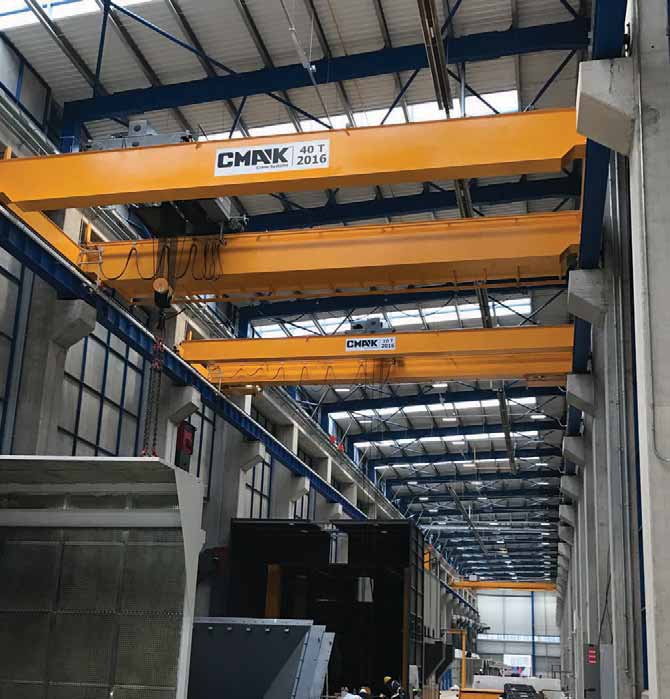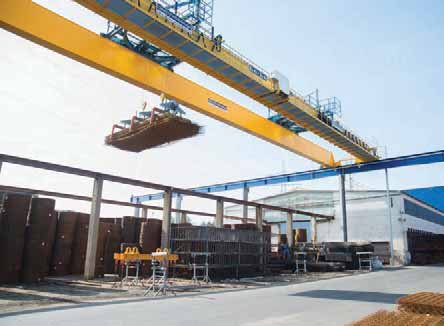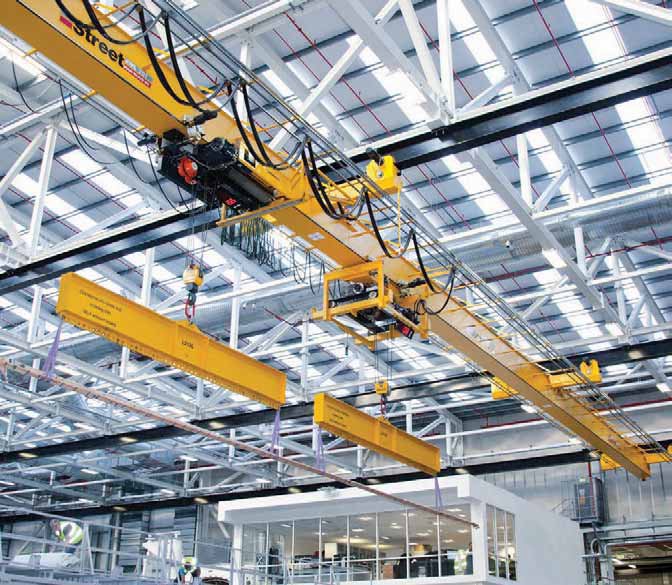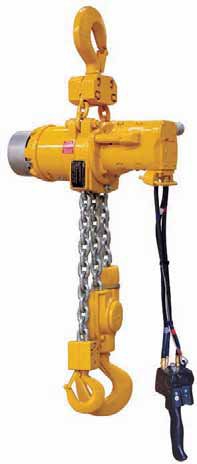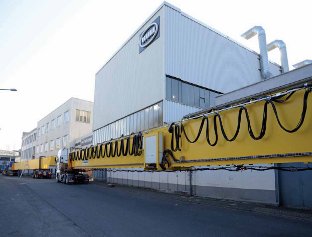Getting Heavy
15 May 2018Makers of trains, industrial machinery, prefabricated concrete elements and other heavy components may need to lift five tonnes or more. Julian Champkin reports on the heavy manufacturing sector.
Street Crane has been supplying heavy-duty cranes to a vast range of manufacturers in sectors that include rail, renewable energy, automotive and industrial, explains Chris Lindley-Smith, the UK manufacturer’s sales director. “What all these companies have in common is that they have required bespoke, high-specification cranes,” he adds. Off-the peg, one-large-size-fits-all, is no longer the story.
Aircraft wings are by any definition large and heavy. Aerospace giant Bombardier needed to lift, move and handle the composite aircraft wings it manufactures at its Belfast plant.
Street provided the means. A key requirement was to keep the production area unobstructed and completely free of crane supports.
The cranes had to be flexible enough to operate effectively in the wide span bay, which is of light construction and designed to flex in response to wind pressure. Street Crane installed some of its most sophisticated overhead cranes at the site. Among them are two cranes with a lifting capacity of 5t apiece which span 20m between the rails, and a third which spans 25m. “The system is unique,” says Lindley- Smith, “as the crane rails form an integral part of the roof structure, rather than being attached to the building columns or supported on gantries. This means that they can operate within the confined space and height restriction of the bay and leave the production area completely unobstructed.” The cranes are suspended from the underside of the tracks and the hoists from the crane bridge. This results in a compact system that has the ability to traverse the load beyond the track line. Each of the cranes has cantilevered extensions to give extended reach.
All three cranes use Street Crane’s ZX64 hoist and have a 6m lift height. The single beam crane bridge is of box girder construction to give the required strength and rigidity. The box beams are hinged to provide flexibility and accommodate movements in the roof structure.
In the main production area, a multispan crane has been installed with a 20t lifting capacity; it has two hoists and four suspension points. Known as the jiggle crane, the first hoist takes most of the weight of the wing and the second provides lateral adjustment allowing the wing to be rotated around the beam axis. It has an overall span of 64m including an additional cantilever at each end.
That does not end Street’s installations for Bombardier. In the assembly area, Street has installed an 8t turntable crane with twin rotating hoists. The innovative design allows the suspended wings to rotate by 200 degrees at the same time as being transported across the full 52m bridge. Hoists and travel motion speeds are variable from 0.4m per minute to 20m per minute with sensorless current vector control for smooth movement and accurate positioning.
“There is certainly not another crane Q Beams of the Kuli DG EOT ready for transport to the site S The KULI 40m DG EOT at work. of this design in the UK,” says Andrew Pimblett, managing director at Street Crane, “and I doubt if there is another anywhere in the world. There is an 80m span double girder underslung crane at Heathrow Airport, which was one of the most unusual cranes that Street has ever built, but the Bombardier crane is in a class above anything ever done in suspended crane systems.”
Lindley-Smith adds: “Given the potentially dangerous operating environments for heavy-duty cranes, safety is paramount. One of the leading cases of accidents involving cranes is misuse by operators. This is leading to a growing number of requests for additional controls and features that make it more difficult to use the crane in a dangerous manner.
“We are now providing controls that ensure hoisting is always carried out with the hoist correctly positioned above the load to prevent side pulling and load swing.” All the Bombardier cranes have a special safe load capacity restrictor and amber flashing lights and audible warnings to indicate their approach; and all are remote radio controlled for operator safety with maximum flexibility, but have the additional safeguard of a push-button pendant for back-up.
Similar considerations applied at an even higher-flying high-tech concern, the RAL Space facility in Oxfordshire. RAL forms a key part of the Rutherford Appleton Laboratory. Involved in more than 210 space missions, RAL Space is home to one of the most sophisticated space design, production and research facilities in Europe. Here too the requirement was for multiple cranes and sometimes-heavy lift capacities that nevertheless leave assembly spaces clear and unobstructed.
The facility is using 14 new overhead cranes from Street Crane to help lift and manoeuvre highly specialist equipment around the 80,700 sq ft site. The facility contains thermal vacuum chambers and 15 cleanrooms and low vibration chambers which recreate conditions in outer space and at blast-off.
Working with main contractor Willmott Dixon, Street Crane designed and installed 11 new overhead cranes with lifting capacities ranging from 0.5t to 10t. These are used throughout the building for lifting and moving scientific equipment and instrumentation and other specialist materials.
Two larger cranes have been recently installed. They feature specially-designed dual hoists that are integrated into common hoist trolleys for independent lifting operations. One has a 50t hoist, used for infrequent heavy lifts and a 15t hoist that gives faster lifting speed intended for smaller loads and regular use.
The other crane is similarly configured with a 30t main lifting capacity and an auxiliary 5t hoist fitted. This 30/5t crane spans the full 35m width of the facilities hall and will be used to transfer space instrumentation and equipment across to the hall’s clean rooms for assembly and testing.
“The larger cranes’ dual hoists have been designed specifically to suit the operation’s requirements on quite significant structures that both span over 35m,” says Lindley- Smith. “The other smaller cranes will ensure that space instruments weighing up to 10t can be lifted and moved very effectively, reliably and safely. Our ZX hoists improve performance and safety while at the same time reduce the need for maintenance. These benefits are essential in such a demanding environment, which has to meet the exacting needs of customers and collaborators.”
Another recent installation by Street is at a fabrication facility in Barnsley, South Yorkshire for Thornhill Heat Exchangers. Thornhill produces a range of large industrial heat exchangers as well as large storage vessels. The products are used in industries including steel manufacturing, food processing, chemical and shipping.
Six Street overhead cranes been installed in the new facility, one with a lifting capacity of 10t and five with a lifting capacity of 15t. The cranes are being used to lift materials such as carbon steel, stainless steel, brass, aluminium and titanium onto machines that are controlled with CNC and used to manufacture the heat exchangers. The cranes will also be used to handle the newly fabricated storage vessels.
The cranes’ ZX hoists are designed to minimise maintenance and maximise reliability—another near-universal customer demand, says Lindley-Smith. Mark Ingram, general manager at Thornhill, says: “We needed overhead cranes that would enable us to efficiently and reliably move large and heavy materials around the new site, ensuring maximum productivity.
“We wanted the assurance that the overhead cranes were of the highest quality and backed by strong after-sales, which to date has been very impressive.”
In Germany, Kuli Hebezeu makes what it markets as the world’s strongest single girder electric wire rope hoist operating on curved monorail track; its capacity is 192t. Lifting for heavy manufacturing would therefore seem to be a speciality.
A recent special project of theirs was for a customer who needs to transport loads up to 25m in length. Kuli has supplied a 40m span DG EOT crane with four hooks on two rotating trolleys, known as crabs. The hooks are of 4t each, giving 16t in combination.
Each hoist can be controlled separately; the crabs can also be controlled separately, or they can be controlled together in synchronisation. The rotation angle of the crabs is 240 degrees. Control is a belly type remote. The travel length is 73m; it has a one-side walkway and platforms at the crabs.
A special requirement of the customer was high speeds: up to 32m a minute cross travel, and up to 63m a minute lateral travel. On the DG EOT these are all frequency inverter controlled. The crane was assembled in 2017 by Kuli’s own staff.
CMAK Crane Systems specialises in heavy electric crane equipment for industry, with vast experience over designing custom material handling applications up to and including 250t custom-built winches. Faurecia is the eighth largest manufacturer of automotive parts manufacturer in the world. It has been using CMAK products for more than a decade; a recent purchase was a 40t overhead crane for their injection mold handling.
Ingersoll Rand is another company offering winches and hoists for heavy manufacturing, with capacities from 125kg—at the light end—to 100t. Arnaud Bruneel, its global product specialist, says safety is the primary consideration. The company’s hoists and winches are all designed to DNV specifications. Another design feature is modularity.
“We do not design each new product from scratch, but build on existing models. Our whole range, from smallest to largest, have components in common,” Bruneel explains.
This, he says, gives an advantage in customisation: “Because our product range is so large, and because we design using modular components which will all fit together, we can pick components off the shelves and combine them to make a hoist or winch that fits the customers exact requirements. We do not believe any other manufacturer has that range and ability.”
The modularity plays its part in maintenance, says Bruneel: “A factory will have a range of lifting apparatus, from small winches to large hoists, to handle its many operations. A single maintenance kit can serve them all, from the smallest 300kg winch to the large 6t hoist.” This gives clear savings in economy and simplicity.
Implicit in the above is an echo of Lindley-Smith’s point that customers now want lifting gear tailored for very specific applications. Some need, even inside the factory, waterproofing:
“We can do that, with rust-proof bolts, with corrosion-proof paints. An example is from a recent client whose business is renovating and pressure-cleaning concrete panels. He uses jets of high-pressure water. The panels are suspended from the hoist; water is shot at them at high pressure; and water, mud, dirt and the rest streams off. It is quite spectacular to see it in action; and the hoist has to withstand that wet and dirty environment.” says Bruneel.
“Our products can use hydraulic power, or run off compressed air. That gives an advantage in water-drenched applications: without electricity there is no possibility of electrical shorting.”
And similarly, without electricity they do not produce sparks—a quality needed for hazardous applications or in ATEX environments. “One customer lifts batteries from forklift trucks for re-charging. The gases given off could ignite; so ATEX certification is needed for that,” he says. Hydraulic power for winches and hoists is nothing new—Ingersoll Rand made the first hydraulic hoist in 1923, says Arnaud—but hazardous environments are a market well suited to them.
Customers are asking for customisation: for faster speeds, but, even more, for speeds that are infinitely variable to suit their needs—a demand which hydraulics and compressed-air power can deliver, and in the compact sizes that are also being asked for. The demand, he says, is not only for heavier capacities: customers are also increasingly wanting to lift smaller loads but more frequently with greater precision total repetition and an absolute adaption to the specific role.
“For instance, the automotive industry might want a windscreen lifted into position 2,000 times a day; the machine does only that, but does it exactly the same each time,” says Bruneel.
“Changing the mould in the press that produces the body shells is similar, but the parts are larger and much heavier. It needs hoists that can take a heavier load but with similar repeatability.”
Digitisation and Industry 4.0 is an increasing demand here: “Wireless control of different applications makes the operator more flexible in where he can stand and what he can view. And it gives extra data that electronic data gathering can bring.
“A power plant has four of our 25t hydraulic hoists. The operator can use them separately, but from a single digital controller, or use all of them at once to give a 100t lift. Increasing sophistication in controls. There is a generation of people who have been brought up on smartphones, and this is part of that trend.”
